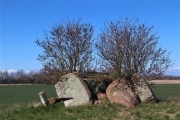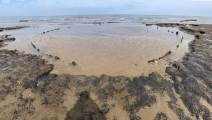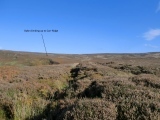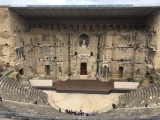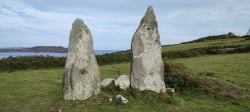Andy Burnham's Blog, page 108
April 21, 2023
Tregune Menhir
A possible menhir, but I can find no data for it. The Cornwall HER map has no entry for any period in this vicinity. There are no drill holes or metal fixings on it so a gate post seems unlikely but it could be of any date? It is located on the last turn of the road to Tregune Farm - near boundary walls.
Published on April 21, 2023 12:07
Bladstrup Ærtesten Jættestue
The remains of a Jættestue (Passage Grave) named "Ærtesten" near Odense (Fyn).
Situated on a rectangular grassy low mound.
The chamber is rounded in shape, oriented north-south
and consists of 5 upright carrying stones, and a loose fallen against the west. A large capstone has shifted into the chamber, filling in part of this. The stone is cleaved on the east side.
Situated on a rectangular grassy low mound.
The chamber is rounded in shape, oriented north-south
and consists of 5 upright carrying stones, and a loose fallen against the west. A large capstone has shifted into the chamber, filling in part of this. The stone is cleaved on the east side.
Published on April 21, 2023 10:35
April 19, 2023
Our New Megalithic Portal Responsive Design is Live!
Our new responsive, mobile friendly layout and design is now live as you will see around us. The new design adapts automatically to different page sizes including mobile screens, so we no longer need the separate, simplified m. pages. It is also has larger font sizes and is better for accessibility generally.
Published on April 19, 2023 05:47
April 16, 2023
Holme II
This is the other timber circle still on Home beach, not the original Seahenge which is in Lynn Museum. This one is being gradually washed away. It could be what remains of a burial mound and has been radiocarbon dated to 2049BC, the time of Seahenge, There are also various other Bronze Age features to be found on the beach, see the other photos for more. Top photo by Tom Charlton @TomCharlton25 on Twitter, used with permission.
Published on April 16, 2023 07:51
April 15, 2023
Aidonia
The Mycenaean cemetery of Aidonia includes more than 20 high quality chamber tombs of the 16th-14th century BC, and still more are being excavated. Many tombs at the site contained elite burial goods such as gold signet rings and jewellery of various types and were devastatingly looted in the 1970s. The "Aidonia Treasure" was returned to Greece in 1993, now on display in the museum of Nemea.
Published on April 15, 2023 05:41
April 14, 2023
Billy's Dyke
Also known as Cromwell's Lines and referred to as Cliff Dyke in the 1642 perambulation of the Helmsley Estate. It is a prehistoric bronze or iron age linear boundary dyke which runs north - south along the western scarp-edge of Urra Moor, more or less following the 340 to 350m contour from Carr Ridge at about NZ 57802 03117 in the north to SE 57653 99565 above William Beck Farm in the south. This is a work of some magnitude for this part of the world, extending some 4.4 km (23/4 miles) and is in fact thought to have been even longer as the present day end points are not though to be original. Note: The descent from the northern end at Carr Ridge to Haggs Gate (Top of Clay Bank) was referred to as Cliff Ditch in the 1637 perambulation of Bilsdale Kirkham.
Published on April 14, 2023 05:55
Northern Earth Issue 171 Out Now
In this issue: Erie Adventures - Justin Patrick Moore takes us on an esoteric ramble around Sandusky, Ohio
The Call of the Cuckoo - Whether its a cuckoo or a gowk where you live, its garnered a lot of placenames around the country, and Jeremy Harte wonders why
Cuckoos Nests - A couple of sidelines from Jeremy Hartes discussion
W: An afterlife - In NE165, we asked readers a question about
subjective responses to variants of the letter W. John Billingsley reports back and asks if one variant is heavy with meaning
The Alt-Antiquarian - The arcane and obscure may enliven some neo-antiquarian conversations, but may also obscure a toxic political subtext
Mike Haighs Archaeology Review - An amateur researchers hunch leads to a potentially valuable insight into notation in prehistoric cave art
The Call of the Cuckoo - Whether its a cuckoo or a gowk where you live, its garnered a lot of placenames around the country, and Jeremy Harte wonders why
Cuckoos Nests - A couple of sidelines from Jeremy Hartes discussion
W: An afterlife - In NE165, we asked readers a question about
subjective responses to variants of the letter W. John Billingsley reports back and asks if one variant is heavy with meaning
The Alt-Antiquarian - The arcane and obscure may enliven some neo-antiquarian conversations, but may also obscure a toxic political subtext
Mike Haighs Archaeology Review - An amateur researchers hunch leads to a potentially valuable insight into notation in prehistoric cave art
Published on April 14, 2023 04:32
April 13, 2023
Roman Theatre of Orange
A Roman theatre built early in the 1st century AD and still in use today! One of the best preserved of all Roman theatres, in Vaucluse, Provence. The wall was originally decorated with marble mosaics of many different colours, multiple columns and friezes, and with statues placed in niches. The central niche contains a 3.4m (11ft) statue of the emperor Augustus, although this was most likely a restoration of an original statue of Apollo,
Published on April 13, 2023 10:09
April 11, 2023
Comillane
A spectacular stone row on Cape Clear island, Comalán townland, Co. Cork. One of the stones has fallen. On a level patch of ground, below a rocky knoll at the North-East end of the island.
Published on April 11, 2023 11:29
Muradamsvej Helleristninger (Modern)
On a rocky outcrop on the island of Bornholm you will find two modern petroglyphs that combine typical prehistoric motifs such as the ship and wheel crosses with the modern. One of the motifs is a tractor pulling a plough. On the rock next to the petroglyphs is a wooden bench and a big stone. It's a nice place for a little break.
Published on April 11, 2023 03:01


